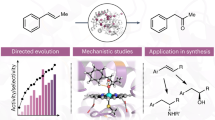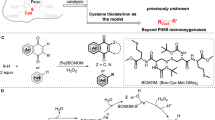Abstract
A highly conserved threonine in the active site of cytochromes P450 has been proposed to participate in O2 binding and cleavage. Cytochrome P450eryF is unusual in having alanine in place of this threonine and an ordered active site water molecule (Wat 519) which is hydrogen bonded to the substrate 5-hydroxyl group and is in position to operate as an acid catalyst required for cleaving dioxygen. To asses the role of this alanine residue and Wat 519 in catalysis, two mutant forms of P450eryF (Ala→Ser, Ala→Thr) and a substrate analogue lacking a 5-hydroxyl group were examined using kinetic, spectral and crystallographic techniques. In each case decreased catalytic activity was correlated with a loss or repositioning of Wat 519. These findings suggest that P450eryF utilizes the substrate to assist in the acid-catalysed dioxygen bond cleavage reaction.
This is a preview of subscription content, access via your institution
Access options
Subscribe to this journal
Receive 12 print issues and online access
$259.00 per year
only $21.58 per issue
Buy this article
- Purchase on SpringerLink
- Instant access to full article PDF
Prices may be subject to local taxes which are calculated during checkout
Similar content being viewed by others
References
Raag, R. & Poulos, T.L. X-ray crystallographic studies of P450cam; factors controlling substrate metabolism in Frontiers in Biotransformations, Vol 7: 1–43 (K. Ruckpaul and H. Rein, eds.) 1–43 (AkademieVerlag, 1992).
Poulos, T.L., Finzel, B.C. & Howard, A.J. Crystal structure of substrate-free Pseudomonas putida cytochrome P-450. Biochemistry 25, 5314–5322 (1986).
Poulos, T.L., Finzel, B.C. & Howard, A.J. High-resolution crystal structure of cytochrome P450cam. J. Mol. Biol. 195, 687–700 (1987).
Nelson, D.R. & Strobel, H.W. Secondary structure prediction of 52 membrane-bound cytochromes P450 shows a strong structural similarity to P450cam. Biochemistry 28, 656–660 (1989).
Matinis, S.A., Atkins, W.M., Stayton, P.S. & Sligar, S.G. A conserved residue of P450 involved in haem-oxygen stability and activation. J. Am. Chem. Soc. 111, 9252–9253 (1989).
Imai, M. et al. Uncoupling the cytochrome P450cam monooxygenase reaction by a single mutation, threonine-252 to alanine or valine: a possible role of hydroxy amino acid in oxygen activation. Proc. Natl. Acad. Sci. USA 86, 7823–7827 (1989).
Ravichandran, K.G., Boodupalli, S.S., Hasemann, C.A., Peterson, J.A. & Deisenhofer, J. Crystal structure of hemoprotein domain of P450BM-3, a prototype for microsomal P450's. Science 261, 731–736 (1993).
Li, H. & Poulos, T.L. Modeling protein-substrate interactions in the heme domain of cytochrome P450BM-3 . Acta Crystallogr. Sect. D D51, 21–32 (1995).
Haseman, C.A., Ravichandran, K.G., Peterson, J.A. & Deisenhofer, J. Crystal structure and refinement of cytochrome P450terp at 2.3 Å resolution. J. Mol. Biol. 236, 1169–1185 (1994).
Raag, R., Martinis, S.A., Sligar, S.G. & Poulos, T.L. Crystal structure of the cytochrome P-450cam acive site mutant Thr252Ala. Biochemistry 20, 11420–11429 (1991).
Yeom, H., Sligar, S.G., Li, H., Poulos, T.L. & Fulco, A.J. The role of Thr268 in oxygen activation of cytochrome P450BM3. Biochemistry 34, 14733–14740 (1995).
Nebert, D.W. et al. The P450 superfamily: updated listing of all genes and recommended nomenclature for the chromosomal loci. DNA 8, 1–13 (1989).
Andersen, J.F. & Hutchinson, C.R. Characterization of Saccharopolyspora erythaea cytochrome P450 genes and enzymes, including 6-deoxyerythronolide B hydroxylase. J. Bacteriol. 174, 725–735 (1992).
Cupp-Vickery, J.R. & Poulos, T.L. Structure of cytochrome P450eryF involved in erythromycin biosynthesis. Nature Struc. Bio. 2, 144–153 (1995).
Cupp-Vickery, J.R., Li, H. & Poulos, T.L. Preliminary crystallographic analysis of an enzyme involved in erythromycin biosynthesis: cytochrome P450eryF. Proteins 20, 197–201 (1994).
Kimata,Y., Shimada,H., Hirose,T. & Ishimura,Y. Role of Thr-252 in cytochrome P450cam: a study with unnatural amino acid mutagenesis. Biochem. Biophys. Res. Commun, 208, 96–102 (1995).
Howard, A.J. et al. The use of an imagining proportional counter in macromolecular crystallography. J. Appl. Crystallogr. 20, 383–387.
Brünger, A.T. X-PLOR Version 3.1. A system for X-ray crystallography and NMR. (New Haven, Yale University Press; 1992).
Cambillau, C. & Horjales, E. TOM: a FRODO subpackage for protein-ligand fitting with interactive energy minimization. J. Molec. Graphics 5, 174–177 (1987).
Author information
Authors and Affiliations
Rights and permissions
About this article
Cite this article
Cupp-Vickery, J., Han, O., Hutchinson, C. et al. Substrate-assisted catalysis in cytochrome P450eryF. Nat Struct Mol Biol 3, 632–637 (1996). https://doi.org/10.1038/nsb0796-632
Received:
Accepted:
Issue date:
DOI: https://doi.org/10.1038/nsb0796-632
This article is cited by
-
Structural insights into the role of the acid-alcohol pair of residues required for dioxygen activation in cytochrome P450 enzymes
JBIC Journal of Biological Inorganic Chemistry (2020)
-
Crystal structure of nitric oxide reductase from denitrifying fungus Fusarium oxysporum
Nature Structural Biology (1997)



